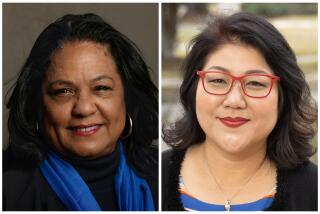Safeguarding Fillmore’s Charm Key for Hopefuls
- Share via
With its historic downtown and turn-of-the-century train depot, locals are fond of calling Fillmore the last, best small town in Southern California.
But the four candidates vying for two seats in Tuesday’s City Council election have drastically different ideas on what it will take to preserve the city’s charm.
Nick Dalton, 47, and Paul Harding, 55, want to put the brakes on large-scale development, saying the city needs to instead focus on pumping life into its downtown, developing the tourist trade and sustaining the surrounding agricultural industry.
Ken Smedley, 57, and Ernest Villegas, 51, embrace a “smart growth” philosophy, saying Fillmore needs to shore up its economic base and generate tax revenue by providing more middle-income and high-end housing and developing a strategy to lure industry and good jobs.
The two incumbents, Linda Brewster and Don Gunderson, are not seeking reelection.
Development has been a crucial issue in the bucolic farm town because of the planned 21,600-home Newhall Ranch project east of the city, just across the Los Angeles County line.
The candidates agree this is a critical election, one sure to shape the future of the Santa Clara Valley city for years.
“This town is going to decide whether it wants to continue building tract homes or whether it’s going to stop and concentrate on saving this last, little great town for our kids and future generations,” said Dalton, a house renovator who moved to Fillmore three years ago.
Dalton said he’s upset with the pace of development, noting city leaders in the last year have approved construction of hundreds of houses. That included last month’s approval of the 750-unit Heritage Valley Park project, the largest development in Fillmore history.
Dalton said he would focus on developing the city’s tourism industry as a way of generating tax dollars and pumping life into the downtown area along Central Avenue. He also would like to see more money budgeted for parks and redevelopment in the downtown core.
“It’s a wonderful valley,” Dalton said. “And it’s going to become more and more valuable as a tourist destination in years to come if we can just preserve it.”
Harding got his start in public life after becoming concerned over development in one of the region’s last predominantly agricultural valleys.
He was a leader of the slow-growth group that fought to place an anti-sprawl measure on the city ballot. Those efforts resulted last year in a city law that shields hundreds of acres of farmland and open space from urban development.
“We need a council that is willing to resist the temptation to build beyond those boundaries, to resist sprawl and to work toward preserving agriculture,” said Harding, a painting contractor and 10-year resident.
Harding said he also wants to develop the tourist trade and reinvigorate downtown. He said he wants to strengthen Fillmore’s Hollywood connection, noting the city already is a choice spot for movie-makers seeking to recreate a small-town feel.
“I’m not a visionary trying to create a better and bigger Fillmore for people coming from somewhere else,” Harding said. “My concern is the improvement of the community for the people currently living in the community.”
Smedley, a city planning commissioner and co-owner of a water-conditioning company, said he wants to concentrate on lifting the city economically through creation of high-end housing and offering opportunities for business expansion.
Smedley, an eight-year resident, disagrees with those who characterize recent development approvals as sprawl.
He cites enactment of the city’s anti-sprawl measure and ongoing efforts to turn a decades-old greenbelt agreement into law as proof that Fillmore is growing carefully.
“My worthy opponents don’t have a clue about what the appropriate and proper definition of sprawl is,” he said.
While continuing to manage growth, Smedley said boosting the city’s sagging economy is the only way to provide parks, recreation programs and other services essential to maintaining Fillmore’s small-town feel.
“If we don’t do this,” Smedley said, “this community will become the place in Ventura County where you go when you can’t go anyplace else.”
Villegas said he also supports development of high-end housing to shore up the city’s economic base.
But Villegas, a 27-year resident and regional manager for Southern California Edison, said it’s also important to ensure that housing is available for residents of all incomes.
“We need to make sure that we have growth that makes sense for our particular community,” said Villegas, a former city planning commissioner and parks and recreation commissioner.
Villegas said City Council members during the next four years will have to deal with a wealth of issues, from redevelopment and business development to protecting the city’s greenbelt and planning for a new sewage treatment plant to meet state standards.
Villegas said he believes his experience in local government gives him an advantage over the competition. “We are losing two experienced council people,” he said. “The issue in my eyes is who can best provide the experience and leadership needed to address the range of issues facing our community.”
More to Read
Sign up for Essential California
The most important California stories and recommendations in your inbox every morning.
You may occasionally receive promotional content from the Los Angeles Times.










